
Photographic plates preceded photographic film as a capture medium in photography. he light-sensitive emulsion of silver salts was coated on a glass plate, typically thinner than common window glass. They were heavily used in the late 19th century and declined through the 20th. They were still used in some communities until the late 20th century.
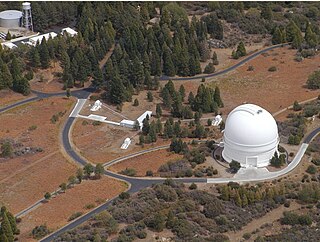
Palomar Observatory is an astronomical research observatory in San Diego County, California, United States, in the Palomar Mountain Range. It is owned and operated by the California Institute of Technology (Caltech). Research time at the observatory is granted to Caltech and its research partners, which include the Jet Propulsion Laboratory (JPL), Yale University, and the National Astronomical Observatories of China.
The Guide Star Catalog (GSC), also known as the Hubble Space Telescope, Guide Catalog (HSTGC), is a star catalog compiled to support the Hubble Space Telescope with targeting off-axis stars. GSC-I contained approximately 20,000,000 stars with apparent magnitudes of 6 to 15. GSC-II contains 945,592,683 stars out to magnitude 21. As far as possible, binary stars and non-stellar objects have been excluded or flagged as not meeting the requirements of Fine Guidance Sensors. This is the first full sky star catalog created specifically for navigation in outer space.
The National Geographic Society – Palomar Observatory Sky Survey was a major astronomical survey, that took almost 2,000 photographic plates of the night sky. It was conducted at Palomar Observatory, California, United States, and completed by the end of 1958.

A Schmidt camera, also referred to as the Schmidt telescope, is a catadioptric astrophotographic telescope designed to provide wide fields of view with limited aberrations. The design was invented by Bernhard Schmidt in 1930.

La Silla Observatory is an astronomical observatory in Chile with three telescopes built and operated by the European Southern Observatory (ESO). Several other telescopes are located at the site and are partly maintained by ESO. The observatory is one of the largest in the Southern Hemisphere and was the first in Chile to be used by ESO.
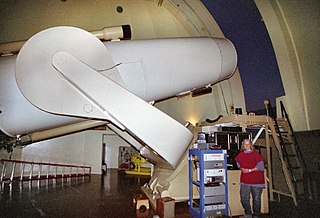
The Samuel Oschin telescope, also called the Oschin Schmidt, is a 48-inch-aperture (1.22 m) Schmidt camera at the Palomar Observatory in northern San Diego County, California. It consists of a 49.75-inch Schmidt corrector plate and a 72-inch (f/2.5) mirror. The instrument is strictly a camera; there is no provision for an eyepiece to look through it. It originally used 10- and 14-inch glass photographic plates. Since the focal plane is curved, these plates had to be preformed in a special jig before being loaded into the camera.
The UK Schmidt Telescope (UKST) is a 1.24 metre Schmidt telescope operated by the Australian Astronomical Observatory ; it is located adjacent to the 3.9 metre Anglo-Australian Telescope at Siding Spring Observatory, Australia. It is very similar to the Samuel Oschin telescope in California. The telescope can detect objects down to magnitude 21 after an hour of exposure on photographic plates.

An astronomical survey is a general map or image of a region of the sky that lacks a specific observational target. Alternatively, an astronomical survey may comprise a set of images, spectra, or other observations of objects that share a common type or feature. Surveys are often restricted to one band of the electromagnetic spectrum due to instrumental limitations, although multiwavelength surveys can be made by using multiple detectors, each sensitive to a different bandwidth.

NGC 7331, also known as Caldwell 30, is an unbarred spiral galaxy about 40 million light-years (12 Mpc) away in the constellation Pegasus. It was discovered by William Herschel in 1784. NGC 7331 is the brightest galaxy in the field of a visual grouping known as the NGC 7331 Group of galaxies. In fact, the other members of the group, NGC 7335, 7336, 7337 and 7340, lie far in the background at distances of approximately 300-350 million light years.

The Royal Observatory, Edinburgh (ROE) is an astronomical institution located on Blackford Hill in Edinburgh. The site is owned by the Science and Technology Facilities Council (STFC). The ROE comprises the UK Astronomy Technology Centre (UK ATC) of STFC, the Institute for Astronomy of the School of Physics and Astronomy of the University of Edinburgh, and the ROE Visitor Centre.
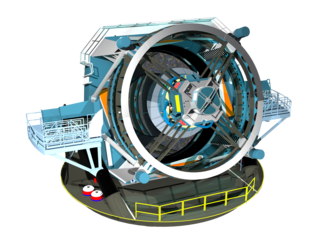
The Vera C. Rubin Observatory, previously referred to as the Large Synoptic Survey Telescope (LSST), is an astronomical observatory currently under construction in Chile. Its main task will be carrying out a synoptic astronomical survey, the Legacy Survey of Space and Time. The word synoptic is derived from the Greek words σύν and ὄψις, and describes observations that give a broad view of a subject at a particular time. The observatory is located on the El Peñón peak of Cerro Pachón, a 2,682-meter-high mountain in Coquimbo Region, in northern Chile, alongside the existing Gemini South and Southern Astrophysical Research Telescopes. The LSST Base Facility is located about 100 kilometres (62 mi) away by road, in the town of La Serena. The observatory is named for Vera Rubin, an American astronomer who pioneered discoveries about galaxy rotation rates.
4007 Euryalos is a larger Jupiter trojan from the Greek camp, approximately 48 kilometers in diameter. It was discovered on 19 September 1973, by Dutch astronomers Ingrid and Cornelis van Houten at Leiden, and Tom Gehrels at Palomar Observatory in California. The likely spherical Jovian asteroid is the principal body of the proposed Euryalos family and has a rotation period of 6.4 hours. It was named after the warrior Euryalus from Greek mythology.
30705 Idaios is a Jupiter trojan from the Trojan camp, approximately 45 kilometers in diameter. It was discovered during the third Palomar–Leiden Trojan survey at the Palomar Observatory in California in 1977. The dark D-type asteroid has a rotation period of 15.7 hours. It was named after the Trojan herald Idaios from Greek mythology.
4754 Panthoos is a Jupiter trojan from the Trojan camp, approximately 53 kilometers in diameter. It was discovered during the third Palomar–Leiden Trojan survey on 16 October 1977, by Ingrid and Cornelis van Houten at Leiden, and Tom Gehrels at the Palomar Observatory in California. It is likely spherical in shape and has a longer-than-average rotation period of 27.68 hours. The assumed C-type asteroid is one of the 80 largest Jupiter trojans. It was named after Panthous (Panthoos) from Greek mythology.
The Palomar–Leiden survey (PLS) was a successful astronomical survey to study faint minor planets in a collaboration between the U.S Palomar Observatory and the Dutch Leiden Observatory, and resulted in the discovery of thousands of asteroids, including many Jupiter trojans.

Time-domain astronomy is the study of how astronomical objects change with time. Though the study may be said to begin with Galileo's Letters on Sunspots, the term now refers especially to variable objects beyond the Solar System. Changes over time may be due to movements or changes in the object itself. Common targets included are supernovae, pulsating stars, novas, flare stars, blazars and active galactic nuclei. Visible light time domain studies include OGLE, HAT-South, PanSTARRS, SkyMapper, ASAS, WASP, CRTS, and in a near future the LSST at the Vera C. Rubin Observatory.

NGC 1433 is a barred spiral galaxy with a double ring structure located in the constellation of Horologium. It is at a distance of 46 million light-years from Earth. It is a Seyfert galaxy with an active galactic nucleus. The central region of the galaxy displays intense star formation activity, with an irregular star-forming ring of 5″ radius and weak radio wave emission. Star formation is also noticeable in the spiral arms but not the bar of the galaxy. NGC 1433 is being studied as part of a survey of 50 nearby galaxies known as the Legacy ExtraGalactic UV Survey (LEGUS). A jet of material flowing away from the central black hole of the galaxy extending for only 150 light-years has been found. It is the smallest molecular outflow ever observed in a galaxy beyond our own.
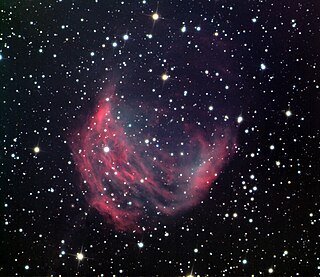
The Abell Catalog of Planetary Nebulae was created in 1966 by George O. Abell and was composed of 86 entries thought to be planetary nebulae that were collected from discoveries, about half by Albert George Wilson and the rest by Abell, Robert George Harrington, and Rudolph Minkowski. All were discovered before August 1955 as part of the National Geographic Society – Palomar Observatory Sky Survey on photographic plates created with the 48-inch (1.2 m) Samuel Oschin telescope at Mount Palomar. Four are better known from previous catalogs: Abell 50 is NGC 6742, Abell 75 is NGC 7076, Abell 37 is IC 972, and Abell 81 is IC 1454. Another four were later rejected as not being planetaries: Abell 11, Abell 32, Abell 76, and Abell 85. Another three were also not included in the Strasbourg-ESO Catalogue of Galactic Planetary Nebulae (SEC): Abell 9, Abell 17, and Abell 64. Planetaries on the list are best viewed with a large aperture telescope and an OIII filter.
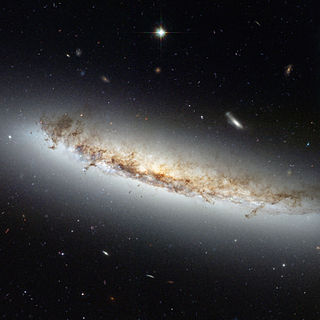
NGC 4402 is a relatively near, edge-on spiral galaxy located around 50 million light-years from Earth. It is in the constellation of Virgo within the Virgo Cluster of galaxies. It can be seen when viewing Markarian's Chain.












